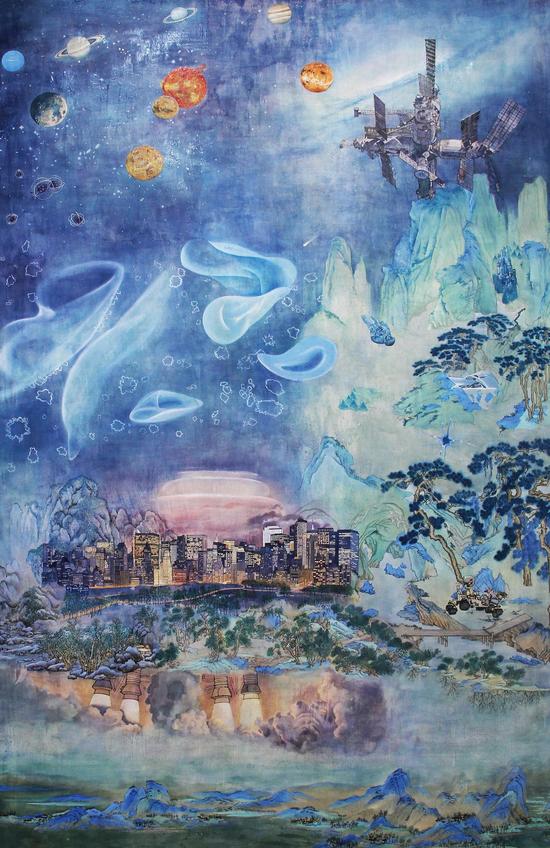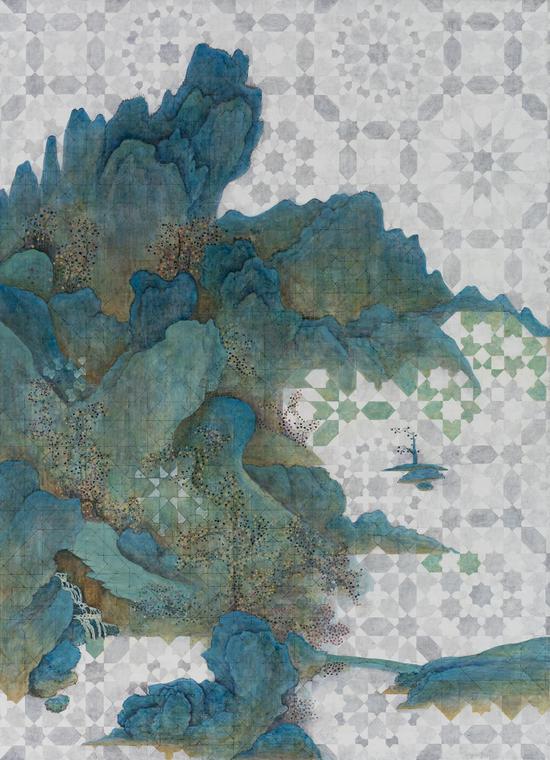展讯 | 代码视界—丛云峰个展
时间:2018/5/22 9:47:49 来源:新浪收藏

丛云峰个展-代码视界-海报
代码视界—丛云峰个展
The Sight of Code—Cong Yunfeng’s Solo Exhibition
学术指导:王萌
开幕:2018.5.26 16:00
展期:2018.5.26-2018.7.1

丛云峰 Cong Yunfeng 查拉图斯特拉如是说:科学 Thus.Spoke.Zarathustra:Science 180x110cm 综合材料 Mixed Materials 2014
芳草地画廊·798很荣幸的宣布,艺术家丛云峰个展《代码视界》将于2018年5月26日16:00开幕,由知名策展人、艺术批评家王萌担任学术指导。本次将展出艺术家三个系列的绘画作品,讲述了从“跨语境综合”到“代码文本”的演变过程,除此之外,还将展现以直播为载体的实验项目,以最直观的方式让观众了解艺术家的创作生活。

丛云峰 Cong Yunfeng 太一的流溢之四 Emanation of the One No
在丛云峰的绘画实验中,充满了全球化时代的在地属性和身份意识,中国文化的主体地位越来越得到艺术家的重视。在那些穿行于绘画内的中国艺术、欧洲艺术、中东艺术和印度艺术的视觉结构中,充满了古代、现代、东方、西方,当下、未来的视觉元素,视觉和代码在这个被艺术家建构的图像结构中滑行,视觉与观念的变化出现在从图形到代码,从现实物象到虚拟数据的“转换情境”,这打破了原有事物的秩序和边界,进入一种信息与数据的“自游写意”状态。在这个语境中,“代码”具有一种“宗教式”的意义,它是产生数据并进一步产生“虚拟现实”的运行基础,丛云峰的绘画探索初步进入了这个“转换美学”的新界面,他所进入的是一个“数据主义”(Dataism)情境。

丛云峰 Cong Yunfeng 二进制-千里江山图 Binary A Thousand Miles of Rivers and Mountains 80x595cm 绢本水墨 Ink on Silk 2016
丛云峰绘画的“代码方式”有其自身的一个演变过程。在《查拉图斯特拉如是说》系列中,一种强行的“跨语境综合”从学院中来但又打破绘画的学院派机制。由这个系列出发丛云峰找到了进入后来创作中“代码文本”的逻辑起点。在《太一的流溢》系列中,几何的“数理属性”和“宗教含义”让丛云峰的绘画朝向完成“代码转向”只差一步之遥。在《二进制》(Binary)系列完成了更为彻底的“代码转型”,这个充满计算机程序思维的“代码意识”的单色图像中,一种“看似”为中国传统水墨山水的外表是丛云峰提供的让阅读发生“误读”的视觉逻辑,任何不经意的“观看”都会产生一种最为朴素的认知结果,即这是一张普通的山水画,然而隐藏在这种“似是”视觉结构中的“却是”一种“代码转换”的观念机制。“代码造型”成为在数据时代重构古代图形引发一种“认知错觉”的图像生成方式,它启示阅读者在“混淆”的认知关系中去思辨这个时代最为容易“被混淆”的虚拟和现实关系。一张同样手绘在绢本上的水墨媒介的绘画,其背后的“绘画动机”绝非再现一幅古代山水的样貌,而是要通过这种同样“有序构图”的“貌似的相似性”去引发对于“绝对差异”的体认。掩饰在在绢本媒介规整山水图像背后的是“0”和“1”的数字代码在观念空间中的“绘画”,丛云峰用一种“数据教”式的“深描”制造了一个“精细”的“视错觉”。代码在图像与绘画中获得了两种空间秩序下的意义:在可视空间,它生成山水图像的阅读结构;在不可视空间,代码与数据在虚拟媒介中带来一种思考,即代码和数据如何作用于我们今天的现实生活?其运动的逻辑和语法是什么?这是一种“文本结构”的内爆,“代码-编织”、“图像-深描”重构了“形象-意义”的再现法则,一幅古代山水的样貌提供了一种21世纪的“数据文化”,我将其归类为最近提出的“转换美学”范畴,这是今天新经济、新业态、新技术时代众多带有与“传统界面”的思维模式和运行方式发生“界面转换”特征的21世纪的“美学新判断”。
展览持续至2018年7月1日,敬请关注!

丛云峰 Cong Yunfeng 二进制-溪山雪意图 Binary Streams and Mountains Under Fresh Snow 80×330cm 绢本水墨 Ink on Silk 2018
Parkview Green Art 798 is pleased to announce that the artist Cong Yunfeng’s solo exhibition “The Sight of Code” will open at 4 pm on May 26, 2018。 Wang Meng, a renowned curator, art critic is invited as its academic advisor。 This exhibition will display three series of the artist’s paintings, which recount an evolution of the artist’s work, themed from “Cross-context Synthesis” to “Coding Text”。 Besides, it will also showcase the artist’s creating process through live-streamed experimental projects to draw the audience closer to the artist。
In Cong’s painting experiments, a geographical attribute and an identity awareness of the Age of Globalization are especially accented, underlying a dominance of Chinese culture in the artists’ creative conception。 In the paintings’ visual structures that are inspired by arts of China, Europe, Middle East, and India, we can find visual elements of the ancient time, the modern, the Oriental, the West, the contemporary, and even the future。 Vision and codes glide through the images constructed by the artist, and the changes of vision and perception happen at the “scene changes,” during which figures transform into codes, and real objects into virtual data。 These changes break the original order and boundary of things, bringing viewers into “Freehand Brushwork” status of information and data。 In this context, codes have a religious significance in that they produce data and further create a platform for the virtual reality to operate。 In this way, Cong’s exploration of painting enters into a new interface of Converting Aestheticism as well as the realm of Dataism。
Cong’s ways of painting with codes have been through an evolution。 In the series of “Thus Spoke Zarathustra,” his forced Cross-context Synthesis comes from the academia but also breaks its mechanism。 From this series, Cong has found a logical start point, from which he gradually transits into his later creations。 In the series “Emanation of the One,” the geometrical shapes’ mathematical identity and religious implication further push Cong’s paintings to a status just one step from converting into Dataism。 In the series “Binary,” Cong accomplishes a more thorough transition into Dataism。 In the mono-tone image that’s constituted with computer programming language and code awareness, a painting with the appearance of traditional Chinese ink painting is offered by Cong to cause misinterpretation in viewers’ visual logic。 Any careless viewing will lead to a rushed conclusion that this is an ordinary Chinese ink painting。 But what lies under the seemingly stereotypical visual structure is a “but” — a code conversion mechanism in perception。
Code modeling has become a popular image-generating method in the Data Age, where artists reconstruct classical images with codes to cause cognitive confusion。 The method inspires viewers to distinguish between what’s real and what’s virtual, conceptions that are most easily confused over in this age。 The motivation behind an ink painting that’s hand-painted on the silk scroll is no longer to reproduce the look of an ancient mountain view, but to inspire viewers’ awareness of the absolute difference through the real and the fake’s same composition and their seeming similarity。 Hiding behind the ink painting on the silk scroll is a painting that’s painted on viewers’ perception space with numbers 0 and 1。 With a Dataistic thick description, Cong creates a delicate visual illusion。 Code acquires different meanings under image and painting’s respective spacial orders: In a visible space, it triggers the interpretation of an ink painting; in an invisible space, it inspires us to think: how codes and data affect our real life? What is their logic and grammar? This is an implosion of the textual structure: “code - weaving” and “image - thick description” together reconstruct the reproduction rule of “appearance - meaning”。 A code-constructed image with the appearance of an ancient ink painting converges into the Dataism of the 21st century。 I would classify it under Converting Aestheticism, a concept that’s only raised recently。 In the age of New Economics, New Industry, New Technology, this is a New Aesthetic Judgement that helps us to distinguish the change of interface from traditional thinking and operating modes into those of the Data Age。
The exhibition will last until July 1, 2018。 Please stay tuned!

(S)丛云峰 Cong Yunfeng 太一的流溢-未 Emanation of the One-Wei 80x244cm 木板坦培拉 Tempera on Wood 2018

丛云峰 Cong Yunfeng 太一的流溢-未 Emanation of the One-Wei 80x244cm 木板坦培拉 Tempera on Wood 2018
关于艺术家
丛云峰
1990 出生于黑龙江齐齐哈尔
2013 毕业于中央美术学院(微博)
2016 毕业英国查尔斯王子传统艺术学院
现工作生活于北京
个展
2018 代码视界-丛云峰个展,芳草地画廊798,北京
主要群展
2018 2018 Art Central, 香港
2018 Art Stage Singapore, 新加坡
2017 跨越大洋:智造-中国当代艺术展,圣地亚哥普罗维登西亚的沙赫特宫,智利
START 2017, SAATCHI GALLERY, 伦敦
循循三:情感意识下非常态的常态性,芳草地画廊·798,北京
2016 本初·当代的语彙,芳草地画廊,北京
循循二:从感知到介入,芳草地画廊,北京
瓦力在哪里?如何捕捉星丛,Goodenough College,伦敦
2015 材料,Goodenough College,伦敦
2014 2014艺术北京,全国农业展览馆,北京
2013 中央美术学院本科生毕业展,中央美术学院,北京
第五届中国国际建筑双年展,北京
About the Artist
Cong Yunfeng
1990 Born in Heilongjiang Province, China
2013 Graduated from Central Academy of Fine Arts, BFA
2016 Graduated from The Prince’s School of Traditional Arts, MA
Currently living and working in Beijing。
Solo Exhibition
2018 The Sight of Code – Cong Yunfeng Solo Exhibition, Parkview Green Art 798, Beijing
Group Exhibitions
2018 2018 Art Central, Hong Kong
2018 Art Stage Singapore, Singapore
2017 Across the Ocean - China: Creation Contemporary, Schacht Palace of Providencia, San Diego, Chile
START 2017, SAATCHI GALLERY, London
Xunxun-3, Parkview Green Art 798, Beijing, China
2016 Inheritances–The Language in Contemporary Art, Parkview Green Art, Beijing, China
Xunxun-2, Parkview Green Art, Beijing
Where’s Wally? Or How to Capture a Constellation, Goodenough College, London;
2015 Material Matters, Goodenough College, London
2014 Art Beijing, National Agriculture Center, Beijing
2013 Central Academy of Fine Arts, Degree Show, Beijing
The 5th China International Architectural Biennial, Beijing

丛云峰 Cong Yunfeng 太一的流溢-未 Emanation of the One-Wei 木板坦培拉 Tempera on Wood 2018 右

丛云峰 Cong Yunfeng 太一的流溢-未 Emanation of the One-Wei 木板坦培拉 Tempera on Wood 2018 左
关于学术指导
王萌,生于1983年,知名策展人和艺术批评家。任职于中国美术馆,毕业于中央美术学院,系中国美术批评家年会学术委员、中国美术家协会综合材料绘画艺委会学术秘书、中国博物馆协会会员。出版学术著作11本,代表作有《今日绘画中的媒介与方法》、《来自水墨的新语境》《抽象艺术新一代》、《从现代出发》、《中国意志》、《敞开视野:水墨的生态》、《图像研究室:水墨进程的一种“显象逻辑”》、《绘画发生中的观念和语言》、《运行中的“非形象”》(即将出版)、《美术馆作为“文化发生场”的启示》。策展作品两次被文化部评为全国年度优秀展览,三次被北京市文化局评为年度北京年度优秀展览。作为“新境界——中国当代艺术展”(澳大利亚国家博物馆)和“无形之形——中国当代艺术展”(德国卡尔舒特艺术中心)视觉艺术策展团队的成员,成功实现了在堪培拉和布德斯多尔夫的项目。
About the Academic Advisor
Wang Meng, born in 1983, is a well-known curator and art critic who works at the National Art Museum of China。 Graduated from Central Academy of Fine Arts (CAFA), he is an academic member of the China Annual Art Critics Assembly, the Academic Secretary of Comprehensive Material Painting Art committee of China Artists Association, and a member of Chinese Museum Association。 He has published 11 books, including, among others, Mediums and Methods in Contemporary Painting, New Contexts in Ink Painting, A New Generation of Abstract Art, Starting with the Modern, Chinese Volition, Open Horizon: Ecology of Wash and Ink, Image Study: Logic of Presentation in Wash and Ink Process, Concept and Language in Painting Process, Working of Non-Figurative System (to be published), and Inspiration from Art Museum as “Cultural Locality”。 The exhibitions he curated were twice awarded the National Annual Excellence Award by the Ministry of Culture and three times Beijing Annual Excellence Award by Beijing Municipal Bureau of Culture。 He was also on the curatorial team for visual art at the two successful exhibitions abroad: “A New Horizon: Contemporary Chinese Art” (Canberra, National Museum of Australia) and “Form of the Formless: Contemporary Chinese Art” (Kunstwerk Charlshuette, Buedelsdorf, Germany)。
[画廊信息]
Information of Gallery
芳草地画廊·798
Parkview Green Art·798
地址:北京市朝阳区酒仙桥路4号798中二街D09
Address: D09, 798 Zhonger Street, No.4 Jiuxianqiao Road, Chaoyang District, Beijing, China
开放时间:周二-周日,10:30-18:30
Opening Hours: Tuesday till Sunday, 10:30-18:30
版权与免责声明:
【声明】本文转载自其它网络媒体,版权归原网站及作者所有;本站发表之图文,均出于非商业性的文化交流和大众鉴赏目的,并不代表赞同其观点和对其真实性负责。如果发现有涉嫌抄袭或不良信息内容,请您告知(电话:17712620144,QQ:476944718,邮件:476944718@qq.com),我们会在第一时间删除。- [艺术]近一年798艺术区新入驻艺术机构超20家!画廊密集上新原因何在?
- [艺术]书山“睿寻”:在北京城市图书馆体验与公共艺术和谐共生
- [艺术]“日月同辉——清华大学美术学院陈辉教授水墨作品巡展”启幕
- [艺术]菅木志雄“空间物象”展览启幕,呈现“物派”艺术魅力
- [艺术]徐惠泉临夏写生:往生命的群山走去,方寸间抒写人之性情
- [艺术]感受丝绸之路文化“交织” 中国文物珍品赴日本展出
- [艺术]香港故宫文化博物馆将推出馆藏专题展
- [艺术]“春暖花开——70油画公社7人作品展”在无锡开展
- [艺术]4月4-7日旅美艺术家朱者赤新作品“源之纠缠”系列亮相纽约国际艺术博览会
- [艺术]34位中法青年艺术家联展亮相中国美术馆
版权所有 2000-2020 上海麟驾艺术品信息有限公司
Copyright 2000-2020 Cnarts.net Incorporated. All rights reserved

|
 |
 |
 |
 |
沪公网安备 31010102006431号 |



